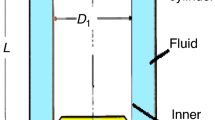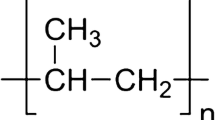Abstract
In the current study, the interactions between egg white albumin (EWA; 0 and 4% w/v) and basil seed gum (BSG; 0 to 0.5% w/v) were investigated using the rheological analyses in a solution system. The Herschel–Bulkley model was able to efficiently describe the flow behavior data. Increasing BSG concentration resulted in a significant increase in the apparent viscosity and yield stress, besides a significant decrease in the flow behavior index. According to amplitude sweep data, the structural strength of the EWA–BSG mixtures improved with the increase in BSG concentration. Power-law model efficiently described the frequency dependence of the experimental mixtures. Overall, the rheological data confirmed some synergistic interactions between EWA and BSG in the case of the mixture solutions containing 4% EWA and 0.3% BSG. This information may be of substantial use where the mixtures of proteins and polysaccharides are used for the stabilization of various food products.

Graphical abstract





Similar content being viewed by others
References
Alghooneh A, Razavi SMA, Behrouzian F (2017) Rheological characterization of hydrocolloids interaction: a case study on sage seed gum-xanthan blends. Food Hydrocoll 66:206–215
Alleoni ACC (2006) Albumen protein and functional properties of gelation and foaming. Sci Agric 63:291–298
Behrouzian F, Razavi SM, Alghooneh A (2017) Evaluation of interactions of biopolymers using dynamic rheological measurements: effect of temperature and blend ratios. J Appl Polym Sci 134(5)
Clark AH, Ross-Murphy SB (1987) Structural and mechanical properties of biopolymer gels. In biopolymers. Springer, Berlin, Heidelberg 57–192
Cox W, Merz E (1958) Correlation of dynamic and steady flow viscosities. J Polym Sci 28:619–622
Croguennec T, Nau F, Brulé G (2002) Influence of pH and salts on egg white gelation. J Food Sci 67:608–614
De Maria S, Ferrari G, Maresca P (2016) Effects of high hydrostatic pressure on the conformational structure and the functional properties of bovine serum albumin. Innovative Food Sci Emerg Technol 33:67–75
Eroglu A, Bayrambaş K, Eroglu Z, Toker OS, Yilmaz MT, Karaman S, Dogan M (2016) Steady, dynamic, creep/recovery, and textural properties of yoghurt/molasses blends: temperature sweep tests and applicability of Cox–Merz rule. Food Sci Technol Int 22:31–46
Friedrich C, Heymann L (1988) Extension of a model for crosslinking polymer at the gel point. J Rheol 32:235–241
Gabriele D, de Cindio B, D'Antona P (2001) A weak gel model for foods. Rheol Acta 40:120–127
Hamzeh SH, Motamedzadegan A, Shahidi SA, Ahmadi M, Regenstein JM (2019) Effects of drying condition on physico-chemical properties of foam-mat dried shrimp powder. Journal of Aquatic Food Product Technology 28(7):794–805
Hesarinejad MA, Koocheki A, Razavi SMA (2014) Dynamic rheological properties of Lepidium perfoliatum seed gum: effect of concentration, temperature and heating/cooling rate. Food Hydrocoll 35:583–589
Hosseini-Parvar S (2009) Basil seed gum (BSG): physico-chemical, rheological and emulsifying characterization and its synergistic interactions in combination with locust bean gum and guar gum. Department of Food Science and Technology Ferdowsi University of Mashhad, Mashhad
Hosseini-Parvar S, Matia-Merino L, Goh K, Razavi SMA, Mortazavi SA (2010) Steady shear flow behavior of gum extracted from Ocimum basilicum L. seed: effect of concentration and temperature. J Food Eng 101:236–243
Hosseini-Parvar SH, Matia-Merino L, Golding M (2015) Effect of basil seed gum (BSG) on textural, rheological and microstructural properties of model processed cheese. Food Hydrocoll 43:557–567
Hosseini-Parvar SH, Osano JP, Matia-Merino L (2016) Emulsifying properties of basil seed gum: effect of pH and ionic strength. Food Hydrocoll 52:838–847
Javidi F, Razavi SM, Behrouzian F, Alghooneh A (2016) The influence of basil seed gum, guar gum and their blend on the rheological, physical and sensory properties of low fat ice cream. Food Hydrocoll 52:625–633
Kasapis S (2008) Phase separation in biopolymer gels: a low-to high-solid exploration of structural morphology and functionality. Crit Rev Food Sci Nutr 48:341–359
Lan Y, Chen B, Rao J (2018) Pea protein isolate–high methoxyl pectin soluble complexes for improving pea protein functionality: effect of pH, biopolymer ratio and concentrations. Food Hydrocoll 80:245–253
Le XT, Turgeon SL (2013) Rheological and structural study of electrostatic cross-linked xanthan gum hydrogels induced by β-lactoglobulin. Soft Matter 9(11):3063
Li J, Eleya MO, Gunasekaran S (2006) Gelation of whey protein and xanthan mixture: effect of heating rate on rheological properties. Food Hydrocoll 20:678–686
Li J, Zhang M, Chang C, Gu L, Peng N, Su Y, Yang Y (2018) Molecular forces and gelling properties of heat-set whole chicken egg protein gel as affected by NaCl or pH. Food Chem 261:36–41
Lorenzo G, Checmarev G, Zaritzky N, Califano A (2011) Linear viscoelastic assessment of cold gel-like emulsions stabilized with bovine gelatin. LWT-Food Science and Technology 44:457–464
Ma CY, Holme J (1982) Effect of chemical modifications on some physicochemical properties and heat coagulation of egg albumen. J Food Sci 47:1454–1459
Mirabolhassani SE, Rafe A, Razavi SM (2016) The influence of temperature, sucrose and lactose on dilute solution properties of basil (Ocimum basilicum) seed gum. Int J Biol Macromol 93:623–629
Monteiro SR, Lopes-da-Silva JA (2017) Effect of the molecular weight of a neutral polysaccharide on soy protein gelation. Food Res Int 102:14–24
Mossel B, Bhandari B, D'Arcy B, Caffin N (2000) Use of an Arrhenius model to predict rheological behaviour in some Australian honeys. LWT-Food Science and Technology 33:545–552
Naji-Tabasi S, Razavi SMA (2017) New studies on basil (Ocimum bacilicum L.) seed gum: part III—steady and dynamic shear rheology. Food Hydrocoll 67:243–250
Onda M, Hirose M (2003) Refolding mechanism of ovalbumin: investigation by using a starting urea-denatured disulfide isomer with mispaired CYS367-CYS382. J Biol Chem
Rafe A, Razavi S (2013) Dynamic viscoelastic study on the gelation of basil seed gum. International Journal of Food Science & Technology 48:556–563
Rafe A, Razavi SM (2015) Effect of thermal treatment on chemical structure of β-lactoglobulin and basil seed gum mixture at different states by ATR-FTIR spectroscopy. Int J Food Prop 18:2652–2664
Rafe A, Razavi SM, Khan S (2012) Rheological and structural properties of β-lactoglobulin and basil seed gum mixture: effect of heating rate. Food Res Int 49:32–38
Rafe A, Razavi SM, Farhoosh R (2013) Rheology and microstructure of basil seed gum and β-lactoglobulin mixed gels. Food Hydrocoll 30:134–142
Rao M, Kenny J (1975) Flow properties of selected food gums. Canadian Institute of Food Science and Technology Journal 8:142–148
Razavi SM, Alghooneh A, Behrouzian F (2018) Thermo-rheology and thermodynamic analysis of binary biopolymer blend: a case study on sage seed gum-xanthan gum blends. Food Hydrocoll 77:307–321
Razavi SMA, Naji-Tabasi S (2017) Rheology and texture of basil seed gum: a new hydrocolloid source. In advances in food rheology and its applications. Woodhead Publishing, pp 405–435
Razavi S, Mortazavi SA, Matia-Merino L, Hosseini-Parvar SH, Motamedzadegan A, Khanipour E (2009) Optimisation study of gum extraction from basil seeds (Ocimum basilicum L.). International Journal of Food Science & Technology 44:1755–1762
Razavi AA, Behrouzian F, Cui SW (2016) Investigation of the interaction between sage seed gum and guar gum: steady and dynamic shear rheology. Food Hydrocoll 60:67–76
Razi SM, Motamedzadegan A, Shahidi A, Rashidinejad A (2018a) The effect of basil seed gum (BSG) on the rheological and physicochemical properties of heat-induced egg albumin gels. Food Hydrocoll 82:268–277
Razi SM, Motamedzadegan A, Shahidi S, Rashidinejad A (2018b) Basil seed gum enhances the rheological and physical properties of egg albumin foams. Food Nutrition Journal: FDNJ-192 10:2575–7091
Razi SM, Motamedzadegan A, Shahidi SA, Rashidinejad A (2019a) Physical and rheological properties of egg albumin foams are affected by ionic strength and basil seed gum supplementation. Int J Chem Eng. https://doi.org/10.1155/2019/2502908
Razi SM, Motamedzadegan A, Matia-Merino L, Shahidi SA, Rashidinejad A (2019b) The effect of pH and high-pressure processing (HPP) on the rheological properties of egg white albumin and basil seed gum mixtures. Food Hydrocoll 94:399–410
Razmkhah S, Razavi SMA, Mohammadifar MA (2017) Dilute solution, flow behavior, thixotropy and viscoelastic characterization of cress seed (Lepidium sativum) gum fractions. Food Hydrocoll 63:404–413
Rhim J, Nunes R, Jones V, Swartzel K (1989) Determination of kinetic parameters using linearly increasing temperature. J Food Sci 54:446–450
Sarika P, Pavithran A, James NR (2015) Cationized gelatin/gum arabic polyelectrolyte complex: study of electrostatic interactions. Food Hydrocoll 49:176–182
Schmitt C, Turgeon SL (2011) Protein/polysaccharide complexes and coacervates in food systems. Adv Colloid Interf Sci 167:63–70
Souza CJ, Garcia-Rojas EE (2017) Interpolymeric complexing between egg white proteins and xanthan gum: effect of salt and protein/polysaccharide ratio. Food Hydrocoll 66:268–275
Su Y, Dong Y, Niu F, Wang C, Liu Y, Yang Y (2015) Study on the gel properties and secondary structure of soybean protein isolate/egg white composite gels. Eur Food Res Technol 240:367–378
Timilsena YP, Adhikari R, Kasapis S, Adhikari B (2015) Rheological and microstructural properties of the chia seed polysaccharide. Int J Biol Macromol 81:991–999
Tunick MH (2011) Small-strain dynamic rheology of food protein networks. J Agric Food Chem 59(5):1481–1486
Tunick M, Onwulata C, Cooke P (2012) Using temperature sweeps to investigate rheology of bioplastics. In: Abstracts of papers of the American Chemical Society, vol 244. Amer Chemical Soc, Washington
Turgeon SL, Beaulieu M, Schmitt C, Sanchez C (2003) Protein–polysaccharide interactions: phase-ordering kinetics, thermodynamic and structural aspects. Curr Opin Colloid Interface Sci 8(4–5):401–414
Van der Plancken I, Van Loey A, Hendrickx ME (2005) Combined effect of high pressure and temperature on selected properties of egg white proteins. Innovative Food Sci Emerg Technol 6:11–20
Vinayahan T, Williams PA, Phillips G (2010) Electrostatic interaction and complex formation between gum arabic and bovine serum albumin. Biomacromolecules 11:3367–3374
Xiong W, Ren C, Jin W, Tian J, Wang Y, Shah BR, Li J, Li B (2016) Ovalbumin-chitosan complex coacervation: phase behavior, thermodynamic and rheological properties. Food Hydrocoll 61:895–902
Xiong W, Ren C, Tian M, Yang X, Li J, Li B (2017) Complex coacervation of ovalbumin-carboxymethylcellulose assessed by isothermal titration calorimeter and rheology: effect of ionic strength and charge density of polysaccharide. Food Hydrocoll 73:41–50
Zameni A, Kashaninejad M, Aalami M, Salehi F (2015) Effect of thermal and freezing treatments on rheological, textural and color properties of basil seed gum. J Food Sci Technol 52(9):5914–5921
Author information
Authors and Affiliations
Corresponding authors
Additional information
Publisher’s note
Springer Nature remains neutral with regard to jurisdictional claims in published maps and institutional affiliations.
Highlights
• Yield stress was highest in the mixture of 4% egg albumin and 0.5% basil seed gum.
• Elastic-like gels were obtained in the case of higher concentrations of BSG.
• Gel network was more temperature-dependent at higher concentrations of BSG.
Rights and permissions
About this article
Cite this article
Razi, S.M., Motamedzadegan, A., Shahidi, SA. et al. Steady and dynamic shear rheology as a toolfor evaluation of the interactions between egg white albumin and basil seed gum. Rheol Acta 59, 317–331 (2020). https://doi.org/10.1007/s00397-020-01198-5
Received:
Revised:
Accepted:
Published:
Issue Date:
DOI: https://doi.org/10.1007/s00397-020-01198-5




